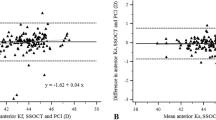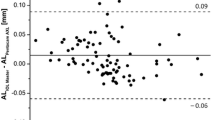Abstract
Purpose
High-resolution biometry of the anterior ocular segment is now becoming more and more important against a background of refractive surgery and the evaluation of potentially accommodative lens replacement materials. The aim of this study was a systematic investigation of the currently available non-contact methods for measuring the anterior chamber depth (ACD).
Methods
The ACDs of 50 phakic eyes of 27 patients aged between 19 and 59 years were measured with the IOL-Master (Zeiss), the AC-Master (Zeiss), the Pentacam (Oculus) and slit-lamp pachymetry by Jaeger (Haag-Streit).
Results
The median anterior chamber depth in the investigated eyes was 3.63 mm for the IOL-Master (minimum 2.88 mm, maximum 4.22 mm), 3.802 mm for the AC-Master (2.816 mm−4.373 mm), 3.915 mm for the Pentacam (minimum 2.994 mm, maximum 4.614 mm) and 3.75 mm for Jaeger (2.887 mm−4.29 mm). With a probability of error of α=0.05 there were no significant differences concerning the ACD between the methods of Jaeger and AC-Master, Jaeger and IOL-Master, or Pentacam and AC-Master (Wilcoxon and Wilcox). The intra-individual variability was ±5.4 μm for AC-Master, ±12.7 μm for Pentacam, ±24.5 μm for IOL-Master and ±41.2 μm for Jaeger. The maximum method-dependent difference in ACD determination was 285 μm.
Conclusions
All the methods allow non-contact biometry, but the results might differ due to measuring principles inherent to the system, experience of the examiner and compliance of the patient. Partial coherence interferometry with the AC-Master offers the advantage of measurement exactly along the optical axis with the highest reproducibility and patient compliance.



Similar content being viewed by others
References
Auffarth GU, Martin M, Fuchs HA, Rabsilber TM, Becker KA, Schmack I (2002) Validity of anterior chamber depth measurements for the evaluation of accommodation after implantation of an accommodative Humanoptics 1CU intraocular lens. Ophthalmologe 99:815–819 (in German)
Augustin AJ (2001) Augenheilkunde, 2nd edn, Springer, p 1062
Bland JM, Altman DG (1986) Statistical method for assessing agreement between two methods of clinical measurement. Lancet i:307–310
Bland JM, Altman DG (1999) Measuring agreement in method comparison studies. Stat Methods Med Res 8:135–160
Drexler W, Baumgartner A, Findl O, Hitzenberger CK, Sattmann H, Fercher AF (1997) Submicrometer precision biometry of the anterior segment of the human eye. Invest Ophthalmol Vis Sci 38:1304–1313
Drexler W, Baumgartner A, Findl O, Hitzenberger CK, Fercher AF (1997) Biometric investigation of changes in the anterior eye segment during accommodation. Vision Res 37:2789–2800
Fercher AF, Mengedoht K, Werner W (1988) Eye-length measurement by interferometry with partially coherent light. Opt Lett 13:186–188
Findl O, Drexler W, Menapace R, Hitzenberger CK, Fercher AF (1998) High precision biometry of pseudophakic eyes using partial coherence interferometry. J Cataract Refract Surg 24:1087–1093
Findl O, Drexler W, Menapace R, Bobr B, Bittermann S, Vass C, Rainer G, Hitzenberger CK, Fercher AF (1998) Accurate determination of effective lens position and lens–capsular distance with 4 intraocular lenses. J Cataract Refract Surg 24:1094–1098
Findl O, Kriechbaum K, Menapace R, Koeppl C, Sacu S, Wirtitsch M, Buehl W, Drexler W (2004) Laser interferometric assessment of pilocarpine-induced movement of an accommodating intraocular lens: a randomized trial. Ophthalmology 111:1515–1521
Koranyi G, Lydahl E, Norrby S, Taube M (2002) Anterior chamber depth measurement: A-scan versus optical methods. J Cataract Refract Surg 28:243–247
Kriechbaum K, Findl O, Kiss B, Sacu S, Petternel V, Drexler W (2003) Comparison of anterior chamber depth measurement methods in phakic and pseudophakic eyes. J Cataract Surg 29:89–94
Lam AK, Chan R, Pang PC (2001) The repeatability and accuracy of axial length and anterior chamber depth measurements from the IOLMaster. Ophthalmic Physiol Opt. 21:477–483
Langenbucher A, Huber S, Nguyen NX, Seitz B, Gusek-Schneider GC, Küchle M (2003) Measurement of accommodation after implantation of an accommodating posterior chamber intraocular lens. J Cataract Refract Surg 29:677–685
Leaming DV (2001) Practice styles and preferences of ASCRS members—2000 survey. J Cataract Refract Surg 27:948–955
Vetrugno M, Cardascia N, Cardia L (2000) Anterior chamber depth measured by two methods in myopic and hyperopic phakic IOL implant. Br J Ophthalmol 84:1113–1116
Vogel A, Dick HB, Krummenauer F (2001) Reproducibility of optical biometry using partial coherence interferometry; intraobserver and interobserver reliability. J Cataract Refract Surg 27:1961–1968
Vilupuru AS, Glasser A (2003) Dynamic accommodative changes in rhesus monkey eyes assessed with A-scan ultrasound biometry. Optom Vis Sci 80:383–394
Author information
Authors and Affiliations
Corresponding author
Additional information
None of the authors has a financial or proprietary interest in any material or method mentioned.
Rights and permissions
About this article
Cite this article
Meinhardt, B., Stachs, O., Stave, J. et al. Evaluation of biometric methods for measuring the anterior chamber depth in the non-contact mode. Graefe's Arch Clin Exp Ophthalmo 244, 559–564 (2006). https://doi.org/10.1007/s00417-005-0103-7
Received:
Revised:
Accepted:
Published:
Issue Date:
DOI: https://doi.org/10.1007/s00417-005-0103-7




